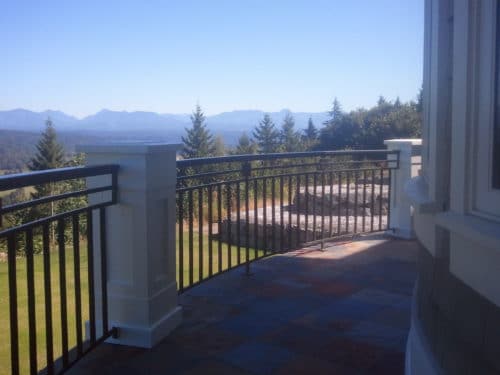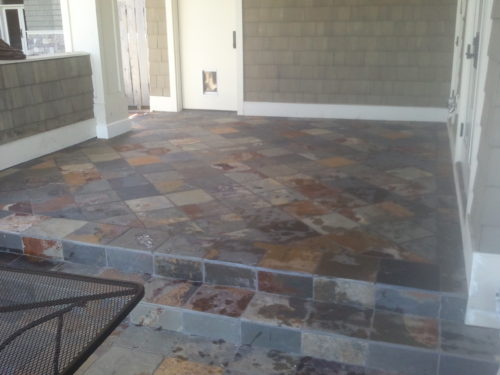This week I got an email about tiling outside over an occupied room. This isn’t something that I’ve talked about so far but this is a high-risk situation and I wanted to expand on it a bit. Here’s the question:
Estimated reading time: 6 minutes

Exterior tile installation over living space
Hello..
I was hoping you could provide some advice. I have lots of experience tiling. I also have successfully installed a wet bed shower. I have a project that I could use your advice on. I have an outdoor balcony that is located directly over a finished room. The existing tile floor is leaking. My guess is the builder cut corners and did not prepare the substraight properly.
The balcony is approximately 18ft by 8ft with a drain in the center. I was going to install a new tile floor in the following manner…
1) install roofing felt
2) nail down galv. wire lathe.
3) apply mortar bed sloped 1/4″ for every foot.
4) apply thin set with membrane on top
5) tile
The is a lot of work for a large area. Do you have any other suggestions? Thank you in advance for your advice.
These exterior tile installations are highly problematic
About two years ago I got to talking with a local representative for one of the major thinset/grout/waterproofing companies in the tile industry.
Amongst his duties are product demonstrations, technical questions, and handling problems that their products may be involved in.
Typically, the number one problem that they have to respond to is grout issues. Discoloration, mold, efflorescence, etc. This is quite common amongst his competitors also.
But as we got to talking, I was quite surprised to hear that this wasn’t the most common issue anymore. It had been replaced by exterior tile installations.
Now keep in mind that I don’t live in Southern California. This is up in the Pacific Northwest. His territory is Washington, Oregon, and Alaska.
Also, keep in mind that every tile installation has grout. Not every tile installation is an exterior balcony.
In fact, they are really not all that common up here. Yet this was his number one technical issue: exterior tile installations- especially over living space.
The reason that I bring this up is that a lot of contractors don’t take these installations seriously. They don’t think there’s anything more to them than a typical bathroom floor.
But there are definitely some things to watch out for with exterior tile installations. Here are a few things that I wanted to talk about:

Waterproofing membranes for outdoors
Liquid membranes typically aren’t a good idea for this application. But it does matter which product it is.
Laticrete, for example, has a great set of instructions for exterior tile installation that involves their Hydroban liquid waterproofing membrane.
However, Hydroban isn’t approved as the primary waterproofing membrane. They don’t specify any of their products to be used as the primary waterproofing membrane.
Choose your waterproof membrane carefully
Your choice in waterproofing membranes is critical. There are only so many that are approved for exterior tile installations.
If it were me, the only membrane that I would consider is Noble Deck by Noble Company. It’s a very thick and tough membrane and it’s made by a company that is a leader in sheet membrane manufacturing.
But it needs to be installed properly. Where it ties into the wall is a critical area and needs to be flashed appropriately.
Another option is from Schluter Systems (page 16). They approve their Ditra membrane for exterior tile installation including those over living space.
But again, reading the instructions is critical. For instance, they want their Troba drainage mat used as part of the system.
There are other products and methods that will work for the primary waterproofing system. Both products that I mentioned above have really good instructions.
They tell you how much to slope the floor, what to install the membranes over, and how the floors should be built. It’s important to do your research before committing to a waterproofing system.
Movement Joints
These are another piece of the puzzle for a successful exterior tile installation. What is a movement joint?
Basically, it’s a grout joint in the tile that isn’t filled with grout. Instead, it’s filled with a flexible sealant like caulking.
For exterior tile installations, you need either a urethane (best choice) or silicone with shore A hardness. Custom Building Products makes a silicone caulk that meets shore A hardness and comes in colors to match their grouts.
The advantage of this is that the silicone joint will be less noticeable if it looks like the grout joints around it.
How many movement joints?
Where do you put these flexible movement joints? For exterior tile installations, they are to be installed every 8 to 12 feet.
So, in the example above, if the exterior balcony is 8 ft. by 18 ft. then you’ll need at least one caulk joint in the middle of the 18 ft. run.
You also need a movement joint around the perimeter of your tile floor. If there is something covering the perimeter then it won’t need to be caulked.
If the perimeter joint can be seen then you’ll need to fill it with the same flexible sealant. Typically a movement joint is about 1/4 inch. but can be bigger if you are near the maximum limit of 12 feet.
Thinset mortar selection for exterior tile installations
Another often overlooked aspect of exterior tile installation is the choice of thinset. For outdoors, you’ll need the strongest and most flexible thinset that you can find.
It needs to meet ANSI 118.15. This grade can be found on the packaging.
You will find a lot more information about thinsets including which specific mortars to use for outdoor tile installations in my post about which thinsets to use and where.

Tile selection for outdoor applications
The best tile selections for exterior tile installations are ones that are impervious. They won’t soak up the moisture. They won’t cause people to slip on them when they get wet.
Typically porcelain tiles are best. They need to meet a slippage test called Dynamic Coefficient of Friction (DCOF). For interiors, the minimum is 0.42 DCOF.
You’ll want to do better than this number for exterior tile installations. For reference, Daltile recommends better than 0.60 for their tiles. It’s something to ask about when shopping for tile.
Slate and other natural stone tile for outdoors
Many people like to shop for slate tile for exteriors. This may seem like an ideal fit.
However, slate is typically a poor choice for exteriors. It’s porous and the layers will chip off over time. A nice non-slip porcelain tile is a much better choice.
So for exterior tile installations, especially those over occupied living space, the details of installation are critical.
With proper research, good installation practices, and good product selections your exterior tile balcony can be counted among the successful installations.